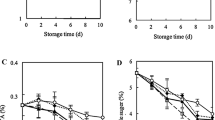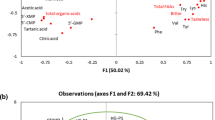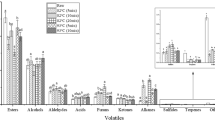Abstract
A main ingredient of Kimchi is Kimchi cabbage, which is soaked in brine to reduce its crispness. Volatile profile of raw Kimchi cabbage (RC) is changed during salting; however, characteristic aroma-active compounds of salted Kimchi cabbage (SC) have not been investigated. The objective of this study was to evaluate changes in aroma characteristics of Kimchi cabbage during salting and fermentation. Sulfur-containing compounds, such as sulfides and isothiocyanates, increased markedly by salting. (Z)-3-Hexen-1-ol, (Z)-3-hexenal, and hexanal decreased by salting. Hexanal was the most intense in RC, followed by 3-(methylthio)butanal, (Z)-3-hexen-1-ol, and benzenepropanenitrile. Dimethyl trisulfide had the highest log3FD in SC. Methyl (methylthio)methyl disulfide, allyl methyl trisulfide, and dimethyl tetrasulfide were detected only in SC. Dimethyl trisulfide, dimethyl tetrasulfide, methyl (methylthio) methyl disulfide, and allyl methyl trisulfide, decreased greatly in SC during fermentation. Our results demonstrated that characteristic odor of Kimchi cabbage could be significantly changed by salting and fermentation.

Similar content being viewed by others
References
Amanpour A, Kelebek H and Selli S. Aroma constituents of shade-dried aerial parts of Iranian dill (Anethum graveolens L.) and savory (Satureja sahendica Bornm.) by solvent-assisted flavor evaporation technique. Journal of Food Measurement and Characterization. 11: 1430-1439 (2017).
Baek HH and Cadwallder KR. Volatile compounds in flavor concentrates produced from crayfish-processing byproducts with and without protease treatment. Journal of Agricultural and Food Chemistry. 44: 3262-3267 (1996).
Buescher RW, McGuire C and Skulman B. Catalase, lipoxygenase, and peroxidase activities in cucumber pickles as affected by fermentation, processing, and calcium chloride. Journal of Food Science. 52: 228-229 (1987).
Cha YJ, Kim H and Cadwallader KR. Aroma-active compounds in kimchi during fermentation. Journal of Agricultural and Food Chemistry. 46: 1944-1953 (1998).
Chin HW and Lindsay RC. Modulation of volatile sulfur compounds in cruciferous vegetables. ACS Publications (1994).
Cho Y and Rhee HS. Effect of lactic acid bacteria and temperature on kimchi fermentation (I). Korean Journal of Food and Cookery Science. 7: 15-25 (1991).
Choi SY, Kim YB, Yoo JY, Lee IS, Chung KS and Koo YJ. Effect of temperature and salts concentration of kimchi manufacturing on storage. Korean Journal of Food Science and Technology. 22: 707-710 (1990).
Choi WY and Park KY. Brining property and antimutagenic effects of organic Chinese cabbage kimchi. Journal of Food Science and Nutrition. 3: 287-291 (1998).
Engel W, Bahr W and Schieberle P. Solvent assisted flavour evaporation–a new and versatile technique for the careful and direct isolation of aroma compounds from complex food matrices. European Food Research and Technology. 209: 237-241 (1999).
Ginzburg B, Dor I, Chalifa I, Hadas O and Lev O. Formation of dimethyloligosulfides in Lake Kinneret: Biogenic formation of inorganic oligosulfide intermediates under oxic conditions. Environmental Science and Technology. 33: 571-579 (1999).
Hatanaka A. The fresh green odor emitted by plants. Food Reviews International. 12: 303-350 (1996).
Hawer WD, Ha JH, Seog HM, Nam YJ and Shin DW. Changes in the taste and flavour compounds of kimchi during fermentation. Korean Journal of Food Science and Technology. 20: 511-517 (1988).
Hwang YS, Lee HW, Chang JY and Seo HY. Characterization of Kimchi flavor with preconcentration by head space solid-phase microextraction and stir bar sorptive extraction and analysis by gas chromatography-mass spectrometry. Analytical Letters. 52: 1247-1257 (2019).
Jang M and Kim GH. Glucosinolate and isothiocyabate contents according to processing of Kimchi cabbage (Brassica rapa L. ssp. pekinensis). Korean Journal of Food Preservation. 24: 367-373 (2017).
Jung JY, Lee SH, Kim JM, Park MS, Bae JW, Hahn Y, Madsen EL and Jeon CO. Metagenomic analysis of kimchi, a traditional Korean fermented food. Applied and Environment Microbiology 77: 2264-2274 (2011).
Kang JH, Lee JH, Min S and Min DB. Changes of volatile compounds, lactic acid bacteria, pH, and headspace gases in kimchi, a traditional Korean fermented vegetable product. Journal of Food Science. 68: 849-854 (2003).
Kim DK, Han KY and Noh BS. Change of lipoxygenase activity in Chinese cabbages submerged in brines. Korean Journal of Food Science and Technology. 29: 576-580 (1997).
Kim MJ, Lee HW, Lee ME, Roh SW and Kim TW. Mixed starter of Lactococcus lactis and Leuconostoc citreum for extending kimchi shelf-life. Journal of Microbiology. 57: 479-484 (2019).
Kim JY, Park EY and Kim YS. Characterization of volatile compounds in low-temperature and long-term fermented baechu kimchi. Journal of the Korean Society of Food Culture. 21: 319-324 (2006).
Ko YD, Kim HJ, Chun SS and Sung NK. Development of control system for Kimchi fermentation and storage using refrigerator. Korean Journal of Food Science and Technology. 26: 199-203 (1994).
Kwon DY, Jang DJ, Yang HJ and Chung KR. History of Korean gochu, gochujang, and kimchi. Journal of Ethnic Foods. 1: 3-7 (2014).
Lee CH. Kimchi; Korean fermented vegetable foods. Journal of the Korean Society of Food Culture. 1: 395-402 (1986).
Mheen TI and Kwon TW. Effect of temperature and salt concentration on kimchi fermentation. Korean Journal of Food Science and Technology. 16: 443-450 (1984).
Miyazawa M and Kawata J. Identification of the key aroma compounds in dried roots of Isatis tinctoria. Journal of Essential Oil Research. 18: 508-510 (2006).
Park IK, Kim SD and Kim SH. Effect of initial temperature of salt solution during salting on the fermentation of Kimchi. Journal of the Korean Society of Food Science and Nutrition. 25: 747-753 (1996).
Sarhir ST, Amanpour A and Selli S. Characterization of Ayran aroma active compounds by solvent-assisted flavor evaporation (SAFE) with gas chromatography–mass spectrometry–olfactometry (GC–MS–O) and aroma extract dilution analysis (AEDA). Analytical Letters. 52: 2077-2091 (2019).
Shahbaz HM, Ryoo H, Kim JU, Kim S, Lee DU, Ghafoor K and Park J. Effects of UV‐C in a Teflon‐coil and high hydrostatic pressure combined treatment for maintenance of the characteristic quality of Dongchimi (watery radish kimchi) during room temperature storage. Journal of Food Processing and Preservation. 41: e13057 (2017).
Shin DH, Kim MS, Han JS, Lim DK and Bak WS. Changes of chemical composition and microflora in commercial kimchi. Korean Journal of Food Science and Technology. 28: 137-145 (1996).
Takeoka G. Flavor chemistry of vegetables. Springer, Boston, MA, USA. pp. 287-304 (1999).
Wajon JE and Heitz A. The reactions of some sulfur compounds in water supplies in Perth, Australia. Water Science and Technology. 31: 87-92 (1995).
Wang J, Gambetta JM and Jeffery DW. Comprehensive study of volatile compounds in two Australian rosé wines: Aroma extract dilution analysis (AEDA) of extracts prepared using solvent-assisted flavor evaporation (SAFE) or headspace solid-phase extraction (HS-SPE). Journal of Agricultural and Food Chemistry. 64: 3838-3848 (2016).
Wu W and Zhao N. Metabolomics of Lactic Acid Bacteria. Springer, Singapore. pp. 167-182 (2019).
Yoon JS and Rhee HS. A study on the volatile flavor components in Kimchis. Korean Journal of Food Science and Technology. 9: 116-122 (1977).
You SY, Yang JS, Kim SH and Hwang IM. Changes in the physicochemical quality characteristics of cabbage Kimchi with respect to storage conditions. Journal of Food Quality. 2017: Article ID 9562981 (2017).
Zhou Q, Liu S, Liu Y and Song H. Comparative analysis of volatiles of 15 brands of extra-virgin olive oils using solid-phase micro-extraction and solvent-assisted flavor evaporation. Molecules. 24: 1512 (2019).
Acknowledgements
This work was supported by National Research Foundation of Korea (2011-0014844).
Author information
Authors and Affiliations
Corresponding author
Ethics declarations
Competing interest
The authors declare no competing financial interest.
Additional information
Publisher's Note
Springer Nature remains neutral with regard to jurisdictional claims in published maps and institutional affiliations.
Rights and permissions
Springer Nature or its licensor (e.g. a society or other partner) holds exclusive rights to this article under a publishing agreement with the author(s) or other rightsholder(s); author self-archiving of the accepted manuscript version of this article is solely governed by the terms of such publishing agreement and applicable law.
About this article
Cite this article
Seo, W.H., You, Y. & Baek, H.H. Changes in volatile flavor compounds of Kimchi cabbage (Brassica rapa subsp. pekinensis) during salting and fermentation. Food Sci Biotechnol 33, 1623–1632 (2024). https://doi.org/10.1007/s10068-023-01469-w
Received:
Revised:
Accepted:
Published:
Issue Date:
DOI: https://doi.org/10.1007/s10068-023-01469-w




